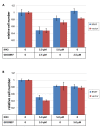The response to PAK1 inhibitor IPA3 distinguishes between cancer cells with mutations in BRAF and Ras oncogenes
- PMID: 22869096
- PMCID: PMC3443253
- DOI: 10.18632/oncotarget.587
The response to PAK1 inhibitor IPA3 distinguishes between cancer cells with mutations in BRAF and Ras oncogenes
Abstract
While new drugs aimed at BRAF-mutated cancers are entering clinical practice, cells and tumors with activating Ras mutations are relatively resistant to those and quite a few other anti-cancer agents. This inspires the effort to reverse this resistance or to uncover new vulnerabilities in such resistant cancers. IPA3 has been originally identified as a small molecule inhibitor of p21-activated protein kinase 1 (PAK1), a candidate therapeutic target in human malignancies. We have tested a battery of melanoma and colon carcinoma cell lines that carry mutations in BRAF, NRAS and KRAS genes and have observed that those with NRAS and KRAS mutations are more sensitive to killing by IPA3. Genetic manipulations suggest that the differential response depends not just on these oncogenes, but also on additional events that were co-selected during tumor evolution. Furthermore, sublethal doses of IPA3 or ectopic expression of dominant-negative PAK1 sensitized Ras-mutated cells to GDC-0897 and AZD6244, which otherwise have reduced efficiency against cells with activated Ras. Dominant-negative PAK1 also reduced the growth of NRAS-mutated cells in confluent cultures, but, unlike IPA3, caused no significant toxicity. Although it remains to be proven that all the effects of IPA3 are exclusively due to inhibition of PAK1, our findings point to the existence of selective vulnerabilities, which are associated with Ras mutations and could be useful for better understanding and treatment of a large subset of tumors.
Figures





References
-
- Maurer G, Tarkowski B, Baccarini M. Raf kinases in cancer-roles and therapeutic opportunities. Oncogene. 2011;30(32):3477–3488. - PubMed
-
- Ribas A, Flaherty KT. BRAF targeted therapy changes the treatment paradigm in melanoma. Nature reviews Clinical oncology. 2011;8(7):426–433. - PubMed
-
- Alsina J, Gorski DH, Germino FJ, Shih W, Lu SE, Zhang ZG, Yang JM, Hait WN, Goydos JS. Detection of Mutations in the Mitogen-Activated Protein Kinase Pathway in Human Melanoma. Clinical Cancer Research. 2003;9(17):6419–6425. - PubMed
-
- Goydos JS, Mann B, Kim HJ, Gabriel EM, Alsina J, Germino FJ, Shih W, Gorski DH. Detection of B-RAF and N-RAS mutations in human melanoma. Journal of the American College of Surgeons. 2005;200(3):362–370. - PubMed
-
- Libra M, Malaponte G, Navolanic PM, Gangemi P, Bevelacqua V, Proietti L, Bruni B, Stivala F, Mazzarino MC, Travali S, McCubrey JA. Analysis of BRAF mutation in primary and metastatic melanoma. Cell cycle (Georgetown, Tex. 2005;4(10):1382–1384. - PubMed
Publication types
MeSH terms
Substances
Grants and funding
LinkOut - more resources
Full Text Sources
Medical
Research Materials
Miscellaneous

